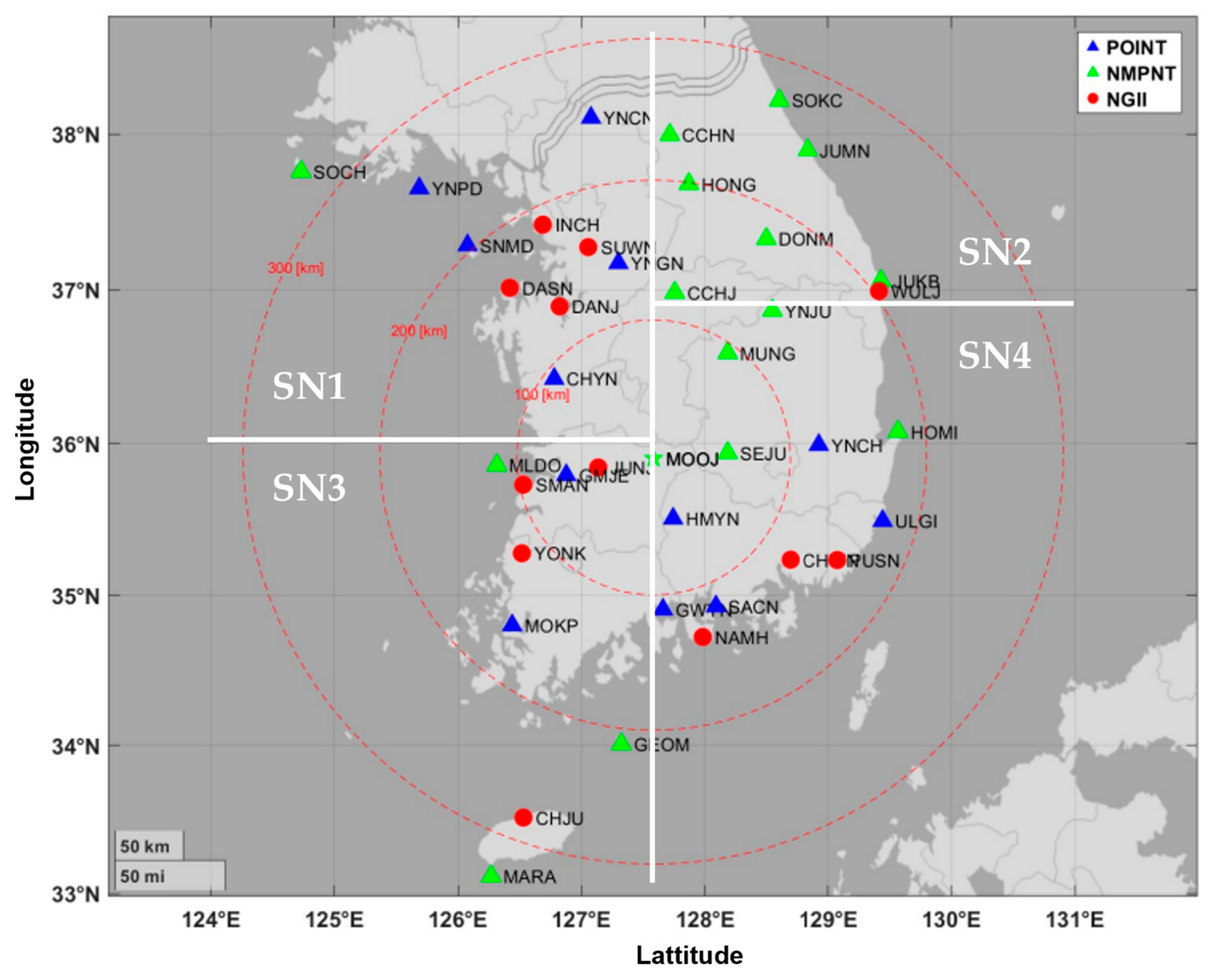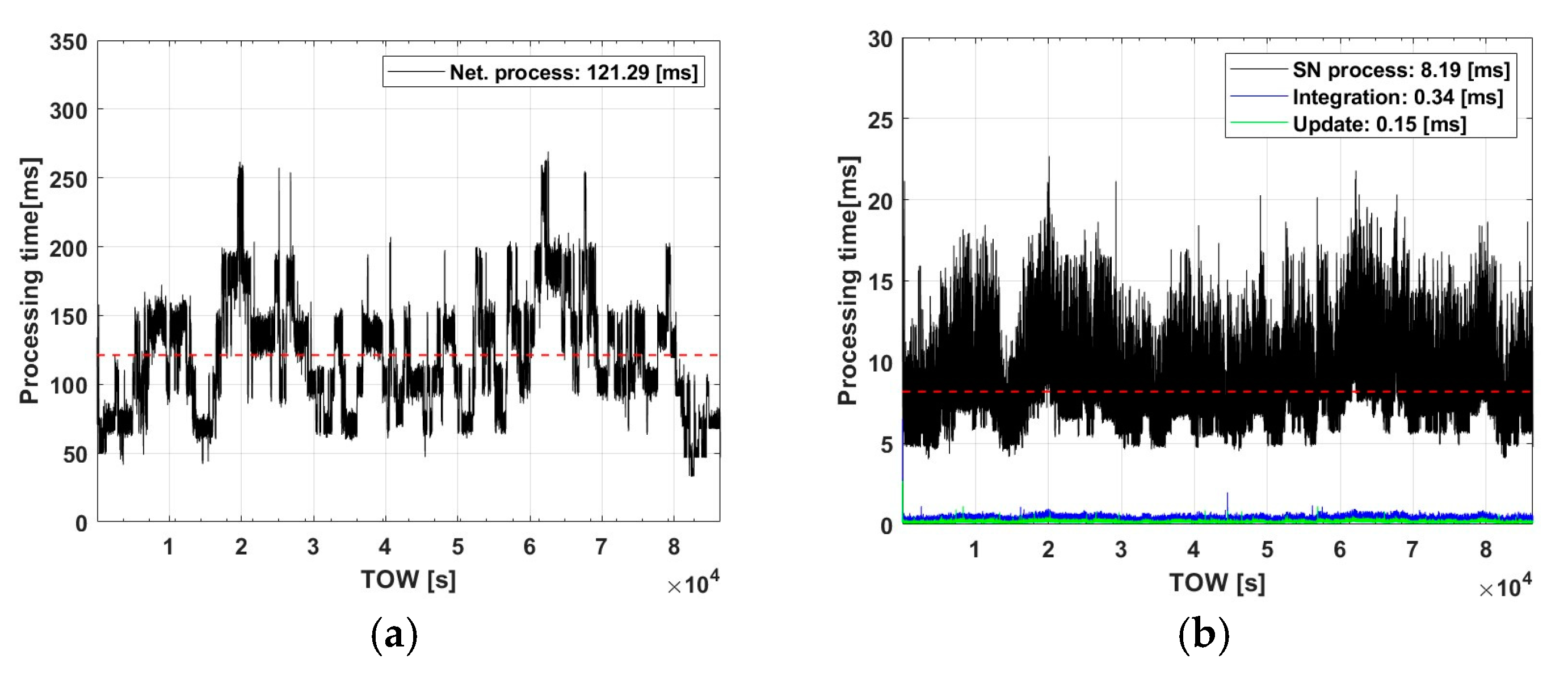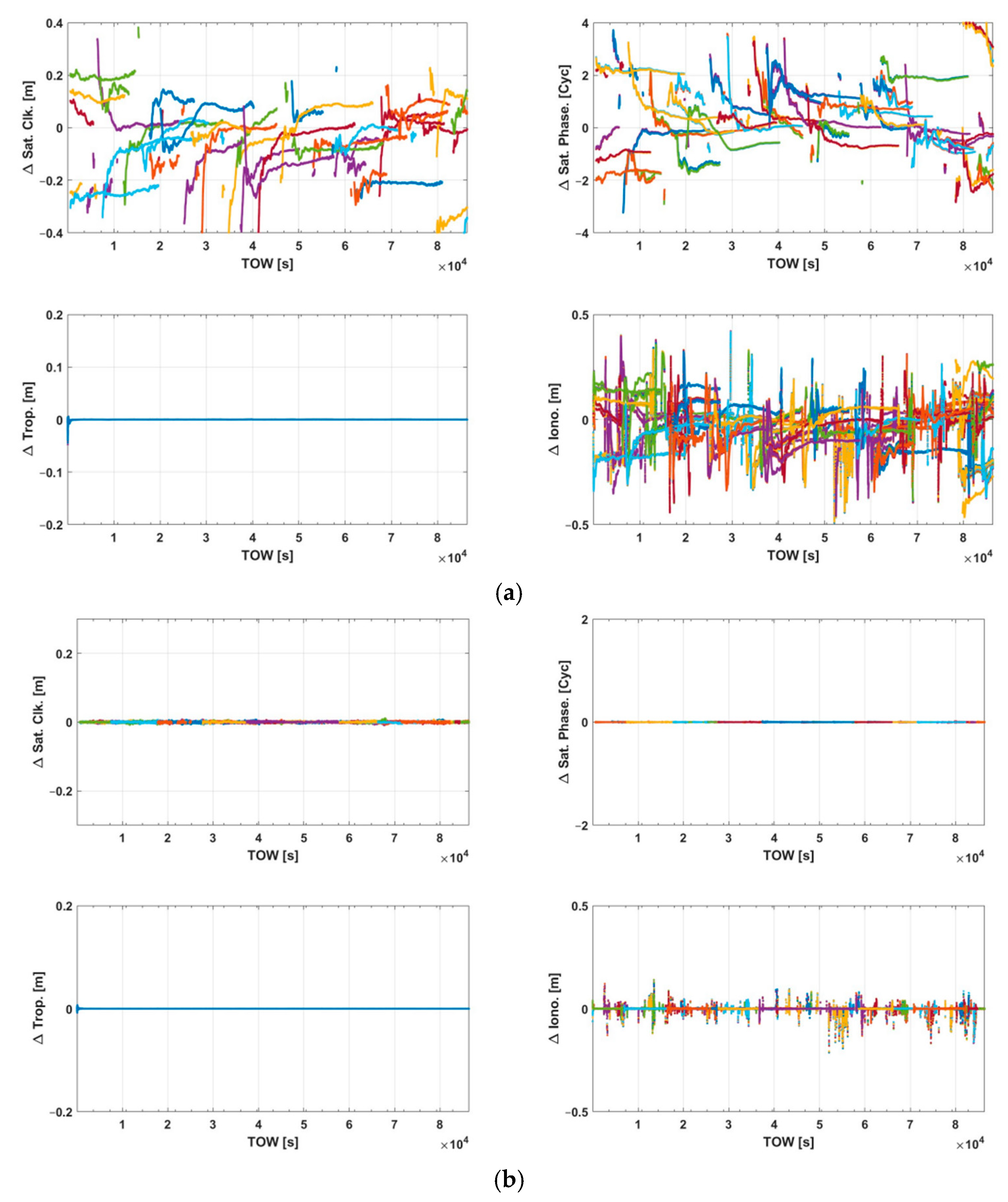Establishing Large-Scale Network PPP-RTK Through a Decentralized Architecture with a Common Pivot Station †
Abstract
:1. Introduction
2. Proposed Decentralized PPP-RTK with Common Pivot Station
2.1. Processing Augmentation Parameters for Each Subnetworks
2.2. Integrating Common Augmentation Parameters
2.3. Re-Updating Subnetwork
2.4. User Model for the Proposed PPP-RTK
3. Results
4. Conclusions
Author Contributions
Funding
Institutional Review Board Statement
Informed Consent Statement
Data Availability Statement
Conflicts of Interest
References
- Angrisano, A.; Gaglione, S.; Gioia, C. Performance assessment of GPS/GLONASS single point positioning in an urban environment. Acta Geod. Geoph. 2013, 48, 149–161. [Google Scholar] [CrossRef]
- Reid, T.G.; Houts, S.E.; Cammarata, R.; Mills, G.; Agarwal, S.; Vora, A.; Pandey, G. Localization requirements for autonomous vehicles. SAE Intl. J. CAV 2019, 2, 173–190. [Google Scholar] [CrossRef]
- Bisnath, S.; Gao, Y. Current State of Precise Point Positioning and Future Prospects and Limitations. In Observing Our Changing Earth. International Association of Geodesy Symposia; Springer: Berlin/Heidelberg, Germany, 2009. [Google Scholar] [CrossRef]
- Zumberge, J.F.; Heflin, M.B. Precise point positioning for the efficient and robust analysis of GPS data from large networks. J. Geophys. Res. Solid Earth 1997, 102, 5005–5017. [Google Scholar] [CrossRef]
- Odolinski, R. Multi-GNSS Integer Ambiguity Resolution Enabled Precise Positioning. Doctoral Dissertation, Curtin University, Perth, Australia, 2015. Available online: https://core.ac.uk/download/pdf/195632004.pdf (accessed on 17 April 2025).
- Odolinski, R.; Teunissen, P.J. Single-frequency, dual-GNSS versus dual-frequency, single-GNSS: A low-cost and high-grade receivers GPS-BDS RTK analysis. J. Geod. 2016, 90, 1255–1278. [Google Scholar] [CrossRef]
- Hou, P.; Zha, J.; Liu, T.; Zhang, B. Recent advances and perspectives in GNSS PPP-RTK. Meas. Sci. Technol. 2023, 34, 051002. [Google Scholar] [CrossRef]
- Odijk, D.; Zhang, B.; Khodabandeh, A.; Odolinski, R.; Teunissen, P.J. On the estimability of parameters in undifferenced, uncombined GNSS network and PPP-RTK user models by means of S-system theory. J. Geod. 2016, 90, 15–44. [Google Scholar] [CrossRef]
- Li, X.; Huang, J.; Li, X.; Shen, Z.; Han, J.; Li, L.; Wang, B. Review of PPP–RTK: Achievements, challenges, and opportunities. Sat. Navig. 2022, 3, 28. [Google Scholar] [CrossRef]
- Hu, J.; Cui, B.; Li, P.; Bisnath, S.; Zheng, K. Exploring the role of PPP–RTK network configuration: A balance of server budget and user performance. GPS Sol. 2023, 27, 184. [Google Scholar] [CrossRef]
- Psychas, D.; Khodabandeh, A.; Teunissen, P.J. Impact and mitigation of neglecting PPP-RTK correctional uncertainty. GPS Sol. 2022, 26, 33. [Google Scholar] [CrossRef]
- Hou, P.; Zhang, B. Decentralized GNSS PPP-RTK. J. Geod. 2023, 97, 72. [Google Scholar] [CrossRef]
- Zha, J.; Zhang, B.; Liu, T.; Hou, P. Ionosphere-weighted undifferenced and uncombined PPP-RTK: Theoretical models and experimental results. GPS Sol. 2021, 25, 135. [Google Scholar] [CrossRef]
- Janssen, V.; McElroy, S. A Practical Guide to AUSPOS. In Proceedings of the Association of Public Authority Surveyors Conference, Leura, Australia, 21–23 March 2022. [Google Scholar]






| Estimable Parameters | Notations |
|---|---|
| Satellite clock bias | |
| Satellite code bias | , (j > 2) |
| Satellite phase bias | |
| Ionospheric delay | |
| Tropospheric delay | , (r > 1) |
| Receiver clock bias | , (r > 1) |
| Receiver code bias | , (r > 1, j > 2) |
| Receiver phase bias | , (r > 1) |
| Receiver DCB | , (r > 1) |
| Integer ambiguity | , (r > 1, s > 1) |
| Estimable Parameters | Notations |
|---|---|
| Integrated satellite clock bias | |
| Integrated satellite phase bias | |
| Integrated pivot ionospheric delay |
| SN + MOOJ[T] (28) | Test Sites (12) | ||||
|---|---|---|---|---|---|
| SN1 (7) | SN2 (7) | SN3 (6) | SN4 (7) | ||
| CHYN[L1] | CCHJ[T] | GEOM[T] | HOMI[T] | CHJU[T] | NAMH[L2] |
| MLDO[T] | CCHN[T] | GMJE[T] | MUNG[T] | CHWN[T] | PUSN[T] |
| SNMD[L1] | DONM[T] | GWYN[L1] | SACN[L1] | DANJ[T] | SMAN[L2] |
| SOCH[T] | HONG[T] | HMYN[L1] | SEJU[T] | DASN[L1] | SUWN[T] |
| YNCN[L1] | JUKB[T] | MARA[T] | ULGI[L1] | INCH[T] | WULJ[T] |
| YNGN[L1] | JUMN[T] | MOKP[L1] | YNCH[L1] | JUNJ[T] | YONK[L2] |
| YNPD[L1] | SOKC[T] | YNJU[T] | |||
| CORS | Central | Decentral | ||
|---|---|---|---|---|
| Horizontal [cm] | Vertical [cm] | Horizontal [cm] | Vertical [cm] | |
| CHJU | 6.74 | 11.29 | 6.22 (7.7%) | 11.01 (2.5%) |
| CHWN | 4.18 | 8.26 | 2.52 (39.7%) | 6.82 (17.4%) |
| DANJ | 6.31 | 8.30 | 4.13 (34.5%) | 4.89 (41.1%) |
| DASN | 6.13 | 10.28 | 4.88 (20.4%) | 7.50 (27.0%) |
| INCH | 7.15 | 10.15 | 4.54 (36.5%) | 6.28 (38.1%) |
| JUNJ | 5.04 | 7.28 | 3.13 (37.9%) | 6.90 (5.2%) |
| NAMH | 4.57 | 9.37 | 3.39 (25.8%) | 6.33 (32.4%) |
| PUSN | 3.18 | 7.17 | 2.52 (20.8%) | 5.41 (24.5%) |
| SMAN | 5.76 | 8.93 | 4.19 (27.3%) | 6.42 (28.1%) |
| SUWN | 7.06 | 11.67 | 5.24 (25.8%) | 10.09 (13.5%) |
| WULJ | 4.30 | 7.98 | 2.93 (31.9%) | 5.51 (31.0%) |
| YONK | 6.94 | 13.79 | 4.77 (31.3%) | 11.19 (18.9%) |
Disclaimer/Publisher’s Note: The statements, opinions and data contained in all publications are solely those of the individual author(s) and contributor(s) and not of MDPI and/or the editor(s). MDPI and/or the editor(s) disclaim responsibility for any injury to people or property resulting from any ideas, methods, instructions or products referred to in the content. |
© 2025 by the authors. Licensee MDPI, Basel, Switzerland. This article is an open access article distributed under the terms and conditions of the Creative Commons Attribution (CC BY) license (https://creativecommons.org/licenses/by/4.0/).
Share and Cite
Lee, C.; Park, S.; Park, S. Establishing Large-Scale Network PPP-RTK Through a Decentralized Architecture with a Common Pivot Station. Eng. Proc. 2025, 88, 37. https://doi.org/10.3390/engproc2025088037
Lee C, Park S, Park S. Establishing Large-Scale Network PPP-RTK Through a Decentralized Architecture with a Common Pivot Station. Engineering Proceedings. 2025; 88(1):37. https://doi.org/10.3390/engproc2025088037
Chicago/Turabian StyleLee, Cheolmin, Sulgee Park, and Sanghyun Park. 2025. "Establishing Large-Scale Network PPP-RTK Through a Decentralized Architecture with a Common Pivot Station" Engineering Proceedings 88, no. 1: 37. https://doi.org/10.3390/engproc2025088037
APA StyleLee, C., Park, S., & Park, S. (2025). Establishing Large-Scale Network PPP-RTK Through a Decentralized Architecture with a Common Pivot Station. Engineering Proceedings, 88(1), 37. https://doi.org/10.3390/engproc2025088037






